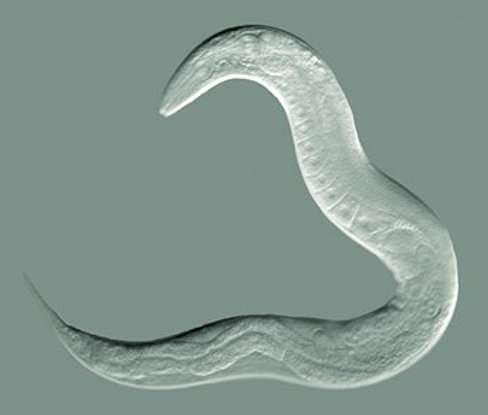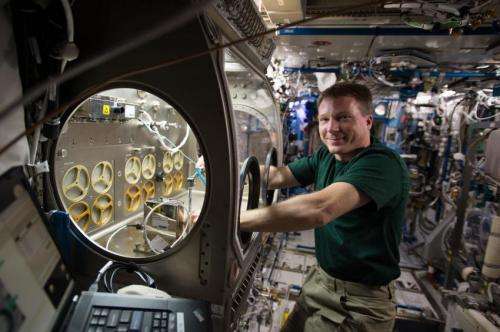Micro-5: Gut reactions in space

Our guts literally teem with beneficial bacteria. But not all bacteria are harmless. Disease-causing bacteria, known as pathogens, can infect our intestines, causing illness or even death. Bacterial pathogens can contaminate the foods and beverages we consume in our everyday diets, and illnesses caused by consuming tainted foods are a serious concern on Earth and in space.
NASA's Micro-5 investigation was launched to the International Space Station on Jan. 10, to help researchers gain a better understanding of how intestinal pathogens cause disease and how we can prevent or counteract foodborne illness in astronauts. Findings from the study also will help researchers develop novel strategies for preventing or treating intestinal infectious disease on Earth.
Tiny roundworms, whose even tinier intestines substituted for human guts in the study, were flown to the orbiting laboratory to become hosts to infection with a bacterial pathogen, Salmonella Typhimurium.
Salmonella, the leading cause of bacterial foodborne illness in the United States, can cause serious illness or death, and there is no vaccine to prevent Salmonella intestinal disease.
The roundworm used in the study—Caenorhabditis elegans (C. elegans)—is a widely studied biological research model, a scientific analog for the human body due to the many genes, biological functions and physiology that are common between humans and C. elegans, including a similar intestinal tract and aspects of the immune system.
"We are studying the entire host-pathogen interaction and infection process in microgravity and measuring virulence in real time," said Cheryl Nickerson, professor at the Biodesign Institute at Arizona State University, Tempe, and principal investigator for the study.

Micro-5 is managed by the Space Biology Project at NASA's Ames Research Center, Moffett Field, California. Funding for Space Biology comes from the Space Life and Physical Sciences Research and Applications Division within the Human Exploration and Operations Mission Directorate at NASA Headquarters. BioServe Space Technologies, University of Colorado Boulder, developed and integrated the payload.
A previous study flown in space entitled Microbe, for which Nickerson also was the principal investigator, showed that Salmonella bacteria became more virulent—more capable of causing disease—when grown in space. This finding is particularly concerning as spaceflight also impairs human immune function, increasing the risk of infection for astronauts.
To perform the study, the station crew injected Salmonella bacteria grown in space into cultures of C. elegans and initiated live video monitoring, allowing researchers on the ground to track the survival of the roundworms in real-time.
Not only will the researchers compare the survival of roundworms that were infected in a weightless environment to those that remained in Earth's gravity, they also will analyze the effect of adding a chemical—phosphate—to the cultures to determine if this protects the worms from infection. They also will investigate the cellular, molecular and immune responses of both the roundworm host and Salmonella pathogen during the infection process to identify novel responses that may be important for disease progression. If this proves to be effective, then a similar approach may someday be used as a nutritional countermeasure to help protect humans from intestinal infections.
The crew collected samples of the infected cultures at specified time points and preserved them for post-flight analysis. Nickerson's science team performed identical operations on Earth at nearly the same time as the astronauts.
The preserved specimens returned to Earth with the SpaceX CRS-5 Dragon spacecraft on Feb.10. Nickerson's team is analyzing these specimens for cellular, molecular and immune response changes to different experimental conditions. The findings will help shed light on the biological mechanisms by which changes in gravity affect the immune response, bacterial virulence and the complex interaction of a living host with an infectious pathogen.
Assessing the gut reactions of a few million roundworms will reveal new information about how gravity affects living systems, and will expand our knowledge of the bacterial infectious disease process both in microgravity and on Earth.
Space is an exciting frontier for biologists such as Nickerson who are studying how living organisms respond and adapt to the unique microgravity environment of the space station.
"Major advances in our knowledge of biological systems come when we study them in extreme environments," said Nickerson. "Spaceflight is the newest extreme environment available for biologists to explore."
Provided by NASA




















